P1: User, Task, and Domain Analysis
Problem Statement
P0: Problem StatementHow can we make recording and tracking nutrition less confusing and more fun in order to motivate users to keep track long term?
Summary of User Observations and Interviews
We wanted to know more about how users approached dining on campus as well as their general knowledge and opinion of nutrition and asked them the following questions:
- 1. What is your diet?
- 2. Where do you usually eat on campus? Why?
- 3. How important is nutrition in your life on a scale of 1-10?
- 4. What are your thoughts on nutrition and diets?
- 5. Have you ever thought about changing diets?
- 6. What is your routine for picking food? Thoughts that go through your mind?
- 7. What is important about the food you eat?
- 8. Describe your interactions with friends on the topic of nutrition and eating on campus.
From our interviews and observations, we have identified four user types: “The User with Dietary Restrictions,” “The Wannabe Health Conscious Eater,” “The Super Health Conscious Eater,” and “The User who has Thought about Changing Diets.”
Most exercise regularly and value convenience and dine at the closest dining hall. One potential user, a vegetarian, goes to Pomeroy specifically for tofu. Most eat with friends half of the time and there is some discussion of diet and nutrition during these interactions. Despite these differences across user types, everyone rated the importance of nutrition in their life highly and agreed that making healthy eating choices is a good habit to pick up.
Where they differ in their value of nutrition is the manifestation of these beliefs. One student with a regular diet does not consider nutrition and instead focused on taste and freshness when picking food and another considers calories and carbs. One took nutrition into account. Shockingly, only one student knows the amount of servings from each food group to eat. It seems that most do not monitor their nutrition due to this lack of information and time constraints. Although they do not spend a lot of time picking food, most have expressed a desire to be more engaged with monitoring their nutrition.
User #1: This user is a sophomore majoring in CS. She is a vegetarian and is lactose intolerant. Health is very important to her. The user exercises regularly and bounces back between Pom (for tofu), Bates, and Lulu for food. She mostly eats alone. On a scale of 1-10, she rates the importance of nutrition in her life 7-8.
User #2: This user is a sophomore CS major who began taking more care of her body this semester, in order to feel better and lead a healthier lifestyle. On a scale of 1-10, she rates the importance of nutrition in her life an 8. She exercises 6 out 7 days a week, and occasionally works out with her friends. For each meal, she makes sure to incorporate a balance of carbs and vegetables and is very knowledgable about what nutrients she needs to eat everyday.
User #3: This user is a very busy junior and has a regular diet. She is majoring in biochemistry. On a scale of 1-10, she rates the importance of nutrition a 6. Despite this, she is not familiar with food groups or serving sizes and typically grabs whatever looks appetizing and fresh from Tower.
From these three interviews, we extrapolated our four personas.
User Analysis
1. The User with Dietary Restrictions

Elizabeth is a sophomore CS major who is vegetarian and lactose intolerant. Although she doesn’t play any sports, she works out 3-4 days a week on a weekly basis. She usually eats at Bates for convenience, but she normally likes to eat at Pomeroy because of their vegetarian options. When she’s hungry late at night, she goes to Lulu for late night. She eats alone about one-third of the time and with friends two-thirds of the time. Her diet choices aren’t impacted by others, but sometimes she will eat dessert depending on when her friends do. She will usually limit her food consumption to one plate and a piece of dessert or two. Nutrition is important to her, but she won’t keep track of nutrition specifically; she will just keep it in mind as she eats, with the exception of 3 nutrients. Because of her vegetarian diet, she does keep track of calcium, protein, and iron. When she decides what food to eat, she considers how hungry she is, what she’s eaten today, if she has had fruit or protein, and whether everything on her plate is a carb or not. Additionally, if something looks delicious or she has no time, she will just grab an unhealthy and/or quick choice, but still try to make up the unhealthiness with healthiness later. She’s not very interested in monitoring her nutrition, especially while at college. She also has not considered becoming vegan or starting to eat meat again.
2. The Wannabe Health Conscious Eater

Emily is a sophomore art history major who has just recently been inspired to lead a healthier lifestyle. She tries to keeps a regular exercising schedule, encourages her friends to workout with her, and tries to be conscious about what she eats. As a resident of Severance, she usually eats in the Tower dining hall due to its proximity. Even with the dining hall’s limited food variety, she fills up her plate with a healthy serving of proteins, greens, and grains at dinner, but is very partial to getting her favorite comfort foods when they appear on the menu, such as mac & cheese or chicken tenders. She is especially eager to try new dining hall dessert items, and feels guilty eating them afterwards. When her week gets too busy, she will often skip working out to catch up on homework or study. Emily’s main motivation in using the app would be help solidify healthier eating habits.
3. The Super Health Conscious Eater

Anna is a junior economics major and a dedicated varsity crew member. She wakes up at 5am every morning to go practice, makes sure to be in bed by 10pm to get enough hours of sleep, and still manages to get all her homework done before then. She resides in Pomeroy for its proximity to the KSC, and often eats in the Pomeroy dining hall for its convenience. She is very conscious about what foods she consumes to maintain her level of fitness and to recover from strenuous workouts. She often avoids high fattening foods in the dining hall, and eats dessert only once or twice a week. Because of the dining halls limited options, she gets salad from the salad bar to eat enough greens. Anna would use the app to maintain her eating habits and to closely monitor a balanced diet.
4. User thinking about improving diet
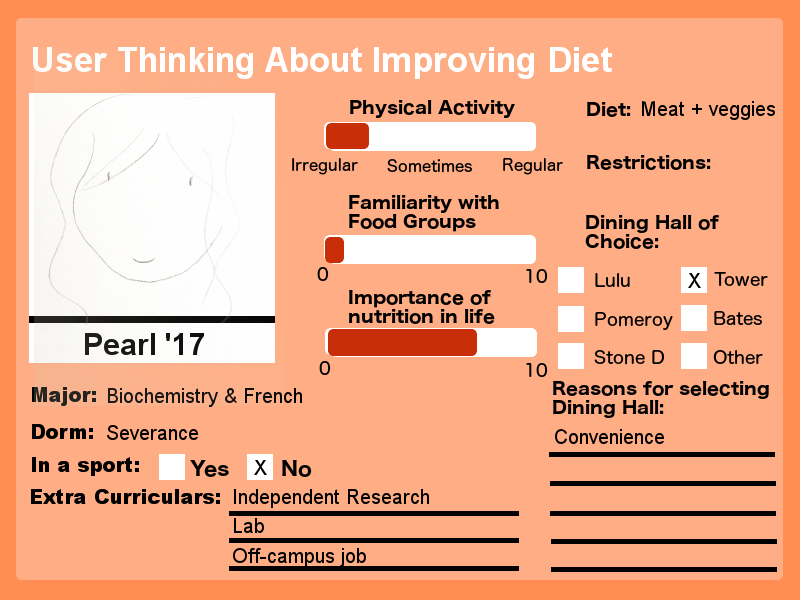
Pearl is a busy junior double majoring in Chemistry and French who, although not actively engaged with maintaining a healthier diet, understands the importance of nutrition and has thought about improving her diet but does not practice this. She has a regular diet consisting of meat and vegetables. Due to her rigid schedule, independent research, and extracurriculars, Pearl usually grabs what looks appetizing and filling after circling the dining hall and feels that the meals are very limited. Even though she typically eats with friends and discusses nutrition with them, her friends do not influence her diet. She would like to be more engaged with monitoring her nutrition but the time required to read up on nutrition remains a big barrier. Pearl rarely has time to read up on nutrition and the food pyramid.
Task Analysis
- 1. Picking a dining hall to eat at
- 2. Picking food to eat
- 3. Learning about eating a balanced diet
- 4. Monitoring their nutrients
- 5. Changing their diet
Task 1: Picking a dining hall to eat at
For every meal, students have to choose which dining hall to eat at. Based on individual surveys and observing Wellesley students, they often decide based on proximity to their current location or based on what each dining hall is serving on how the food items cater to their diets and food preferences.
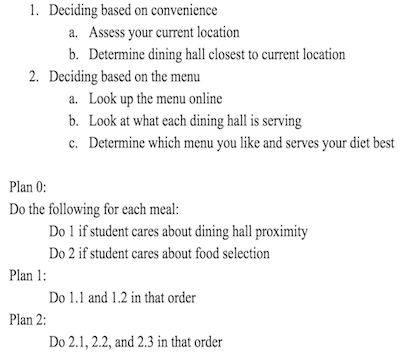

Task 2: Picking food to eat
Students make decisions about what to put on their plates on a daily basis. They evaluate which food items are on the menu, but the process in which they choose may vary among different people because of different diets and preferences. Students often take suggestions from friends, look at what others around them are eating, see which foods taste best, take the healthiest foods, etc.


Task 3: Learning about eating a balanced diet
People often do not know general facts about nutrition and how to eat well. For those who are considering eating healthier, there are many resources they can seek to learn more information. Learning more information online, through books, or from a somebody else can prompt people to reflect on their own diet and what needs improvement.
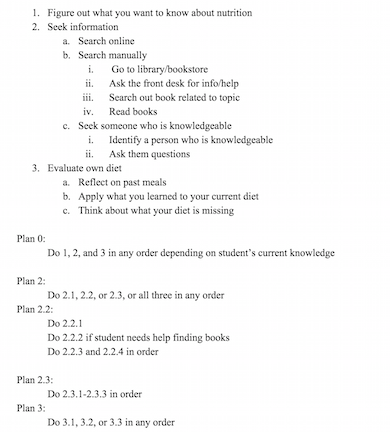

Task 4: Monitoring nutrition for a meal
Students who want to eat healthier or already follow a balanced diet constantly monitor what they eat. When choosing which foods to consume, some things they might think about are which nutrients they need, whether they are eating healthy portions, etc. When aiming to monitor their eating for long periods of time, people can make a mental note or physically keep a log of what they eat.


Task 5: Changing their diet
When people start to take their health into consideration, they may think about changing diets. There is a lot of introspection involved when people choose to change diets, which includes reflecting on their goals, their satisfaction with their current habits, and deciding which diet will be best for them.
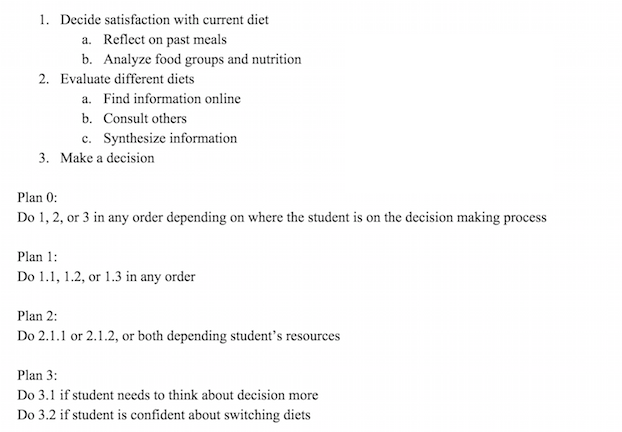
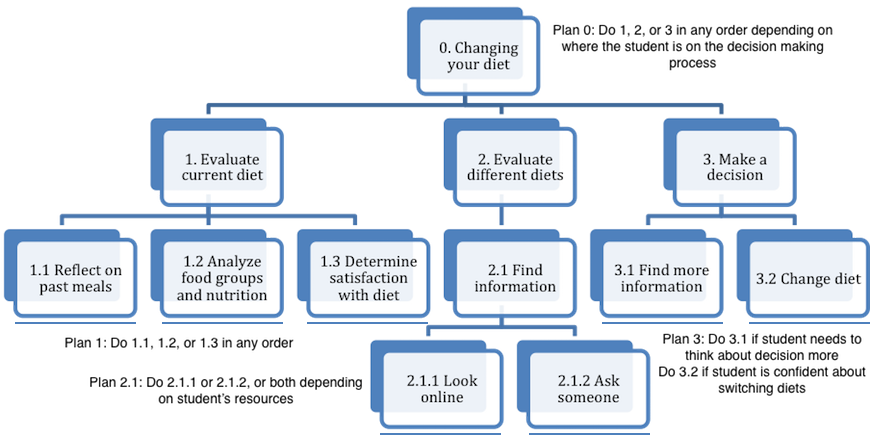
Domain Analysis
